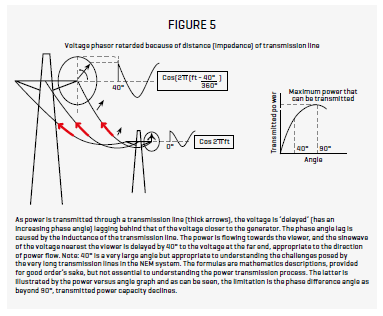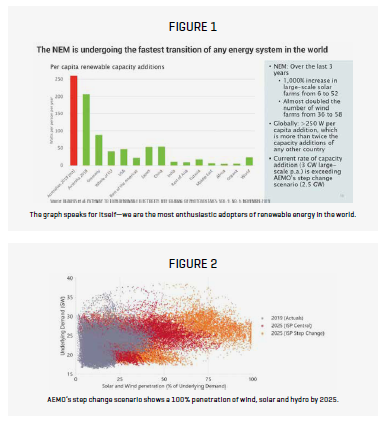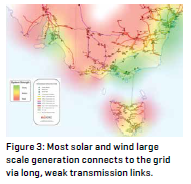Green against black – the future of electricity
The electrical industry is changing and the way we get power already isn’t the same as it always was. Phil Kreveld looks at what’s happening and what it means for electricians on the tools.
Renewable electricity generation—lowering CO2 emission—is hardly ever out of the media. An enthusiastic chorus of green energy supporters is countered by the naysayers: what happens when the sun doesn’t shine or the wind doesn’t blow? Coal-fired boilers, raising steam to power turbine generators, represent security—baseload security but adding a ton of CO2 per MWh to the atmosphere.
ADVERTISEMENT
Enter gas turbine generation—emitting half that amount per MWh and still the cries of protest go out from the ‘greens’. Solve intermittency with pumped hydro—or more controversially, with nuclear power? Protection of the pristine mountainous regions and ‘not in my backyard’ actions can be expected.
But green electricity is gaining the upper hand and is making Australia a unique electrical experiment, watched, written about and discussed by leading international research organisations—and by self-declared pundits. Figure 2, lifted from the Australian Energy Market Operator’s (AEMO) Integrated Systems Study shows where the National Electricity Market (NEM) is headed.
The step-change scenario, orange coloured, is the one to concentrate on because, since the report originated in 2019, that is where we will be by 2025—meeting between 24 to 28GW of national demand with only solar and wind—an impressive 100% penetration!
Question is, can AEMO still operate the NEM reliably, with stability and resilience.
Reliability, stability and resilience, in other words, no interruption to service, voltage and frequency constancy—and if faults occur, a quick bounce-back to normal operation, are musts! The naysayers hold these to be unrealisable if much of the 23GW of synchronous generation currently in use, marches out the door. AEMO estimates that at least 11GW will be closed down over the next ten years.
The Energy Security Board (ESB) which came about after much political haggling over energy policies, has advised the federal government to allow the development of a capacity market, to run in parallel with the electrical energy market. The capacity market might (note: concepts of ‘capacity’ are vague) pay synchronous generator owners for just being available—on standby, ready to generate to fill in the gaps of demand. Many economists, who think they know better than electrical engineers, conclude a capacity market to be a bad idea.
The necessity of baseload generation is thought by many industry watchers and commentators to be essential, irrespective of how much solar and wind might connect to the NEM. But there’s a question around the term ‘baseload’. Before there was significant wind or solar, there were baseload generators—ones that cranked out the same amount of MW, 24/7—and load-following generators. The latter took care of variations in load, i.e., adding power over and above the baseload. The term baseload is now irrelevant because, as a result of solar and wind and the variation in their power output, synchronous generators have to vary their output constantly.
In fact, at times when there is maximum wind and solar generation, synchronous generators have to pay to stay connected to the grid, i.e., negative energy prices for their output.
Most large-scale wind and solar is connected to the national grid via long transmission lines. These very large renewable energy generators (VRE) are located in remote zones. The map in Figure 2 is colour coded to show the remote energy zones (REZ) in red and are considered weak networks, characterised by limited short circuit capacity, in part because of their length.
As is evident, weak networks are in the majority and present a headache to AEMO. Solar and wind generators in REZs experience curtailment because of congestion (too many sharing the same transmission line) resulting in uneconomic operation. In addition, there are technical problems of which voltage oscillation is a major one. The solar farms in the north west corner of Victoria and just across the border in NSW have had to curtail their output on a number of occasions as a result.
Technicians have been sent in a number of times to tune solar farm inverters to limit voltage oscillation but the fixes have been only partially successful. Tuning requires adjustment of inverter phase-locked loop (PLL) circuitry, which basically tracks the voltage sinewave at the inverter’s point of connection (PoC) thus ensuring that the alternating current (AC) output is in phase with the voltage—or that it has a fixed time (phase angle) relationship with the voltage.
Upgrading weak networks is expensive and capital expenditure has to be approved by the Australian Energy Regulator (AER). ‘Anti-gold-plating’ attitudes by the AER essentially prevent upgrades such as an increase in transmission voltage and re-conductering because the resulting increase in transmission charges is considered too high. Yet, upgrading of REZ transmission links to the main transmission lines interconnecting the south-east would make an investment in more VRE attractive. The use of synchronous condensers (syncons) installed at PoCs is a partial solution for increasing the capacity of REZ links.
Currently, the Australian Energy Market Commission (AEMC) is considering proposals for a rule change that would allow the sharing of costs of syncon installations between generators and transmission line operators. Syncons are in essence synchronous generators running as motors, aiding voltage stability and inertia, and can provide leading reactive current (making a transmission line ‘appear’ shorter—i.e., increasing current carrying capacity but not thermal capacity). Syncons require capital expenditures of the order of $100 million per installation. Some savings are available if generators from dismantled power stations are converted for service as syncons.
As already mentioned, Australia is a unique experiment in the adoption of wind and solar. Primarily these forms of generation connect to the grid via inverter-based resources (IBR). Except for two, (Hornsdale and Eyre Peninsula) all IBR are grid following, i.e., they require the presence of stable AC voltage in order to synchronise their AC current output. It seems very likely that other forms of green solar energy such as solar thermal, using reflectors to heat reactors, e.g., molten salt, and salt ponds energizing Rankin cycle turbines will not be substantial contributors. Wind, in particular offshore wind, is likely to continue to grow at a fast rate. It is, therefore, a safe bet that IBRs will continue to be the major contributors to the electrical energy mix and that their integration into networks previously connected to synchronous generators is a main challenge.
It will be obvious that the electrical system cannot run with only grid following IBR if there are no voltage forming generators in the system. As already mentioned, it is the reason why the ESB has advised the federal government to keep some synchronous capacity. There are no major grids in existence that have only IBR providing power!
Battery banks are being constructed throughout the NEM and are classed as grid-supporting. Grid support basically ‘plugs’ power into the grid when there are power drops cause by wind stalls and clouds. Without this facility, synchronous generators would not be able to operate safely.
To explain: a sudden sharp and large change in power demand can cause dangerous mechanical oscillation leading to destruction of turbines. It is an approximate figure but some 20GW of battery capacity (instantaneously available—but for a range of periods) is likely to be in the NEM by 2025 to support about 15GW of synchronous generation. The battery facilities are sometimes presented as the same thing as synchronous generators but this is an erroneous comparison.
Currently, there are no IBR commercially available that could take the place of 100MW and larger rating synchronous generators. GE may have some inverters for trial this year or the next and other manufacturers such as Enphase, SMA, Hitachi-ABB, and Danfoss are sitting on the sidelines, ‘awaiting orders to build’.
In theory, there is no issue in designing IBR that mimics synchronous generation. This requires that IBR have two essential characteristics: power-frequency droop control and voltage-reactive power droop control. There is a diagrammatic representation in figure 4 and an explanation of the two functions.
Additionally, various forms of inertia can be incorporated in the control circuitry. Inertia, something which also gets media attention but without much analysis as to why it might be needed in future electricity systems, is there to provide sufficient slowing in the rate of frequency (RoCoF) change while control systems readjust to get the generator or IBR back on the correct frequency. The faster the control systems operate, the less inertia is needed. However, a note of caution: there are no practical examples for very short, sub-second inertia power systems of any size approaching that of the NEM.
The big question is whether we can ever run a 100% IBR-based renewable network. In theory, the answer is yes. In practice, the answer is a ‘definite maybe’ for all the above reasons.
There is a lot of investigative work going on by bodies such as CIGRE (Conseil International des Grands Réseaux Electriques), EPRI (Electric Power Research Institute), ESIG (Energy Systems Integration Group) AEMO, Monash University, University of New South Wales and other academic institutions. Our practical problem is harnessing all this knowledge into a practical reality. More about this later. One of the major challenges the NEM faces is its physical and ‘electrical’ size and the other one is the unstoppable growth in solar rooftop systems—they are the main component of distribution based energy resources (DER). The large electrical size of the NEM means that there is an appreciable difference in voltage angle between generators way up north and those in the far south east.
Figure 4 shows the concept of voltage angle and its importance in the limitation on power transmission limits.
Nothing much can be done about the size and voltage angle differences but it provides a big challenge as to where, for example, the battery support systems are being situated. Voltage angles take on special significance as power has to flow in reversible directions, e.g., from distant battery banks to synchronous generators. There appears to be little science being applied in the selection of sites based on network stability requirements—in part, because commercial aspects including energy arbitrage dictate site selection, and in part, because we lack enforceable cohesive network stability criteria.
System strength is a concern of AEMO. It is sometimes described as the provision of nice, smooth voltage sinewaves of constant amplitude. A better measure is the availability of constant voltage irrespective of how much current is being drawn—or even more realistically, how much short circuit current can be drawn.
Synchronous generators are able to supply up to 600% of their rated current. Inverters can typically supply between 120% and 150% of their rated current. The challenge, therefore, is the prevention of voltage collapse when there are large increases in power demand on transmission lines. Synchronous generators can keep their voltage up whereas inverters are not as able to do so.
The impedance of the transmission lines are obviously to be as low as possible given their lengths. Transmission line impedance can be lowered by the insertion of a controllable, series capacitor and also by so-called var compensators (which include syncons). As more rooftop solar is installed, the amount of power having to be supplied to distribution substations can drop to very low levels during the day. This can cause the voltage to rise in high voltage transmission lines requiring the use of large, switched inductor banks to reduce the voltage back to the rated level. Strange as this may appear, very low ‘external’ demand from distribution substations is a headache for AEMO and transmission system operators. Who is finally responsible for system strength?
Good question!
Much attention is given to domestic rooftop solar, batteries and community batteries. Falling prices for solar panels and inverters see to it that bigger and bigger rating solar systems are installed in Australian households.
With a current aggregate capacity of around 18GW, we are the world’s leader on a per capita basis. A decade or so ago, the thought of perhaps having to exercise some level of control over this huge generator spread over several million installations, hadn’t occurred. Now the genie is out of the bottle!
Home batteries, although still expensive, are an intelligent way of absorbing energy instead of sending it back to the substations. Community batteries being trialled by some distribution networks are an excellent idea, making energy storage more affordable given that individual home storage batteries have paybacks of between 10 and 15 years. Some distribution networks are trialling control of solar inverters. For example, communicating with smart meters that signal when larger than wanted power export levels occur, and instruct inverters to curtail power output. The idea of being ‘off grid’ has attraction for many communities and is already a realistic aim through the use of large battery energy storage systems (BESS).
Smaller rating voltage forming inverters, of under 10MW are available and can support grid-following inverters of individual households. Diesel generators can be installed to provide emergency backup, i.e., these small ‘off grid’ systems are very much like industrial-scale uninterruptible power supplies (DRUPS). All the above measures raise an interesting question: will we see in years to come a gradual dismemberment of the NEM into smaller, autonomous regions?
We are facing some major problems as we race to higher levels of solar and wind: how do we restart the NEM system after a major blackout, and another question—who is in charge of the integration of renewables and network design to accommodate them?
There is no ‘system black’ restart possible other than by the existing fleet of synchronous generators. Battery systems, supported by turbine systems s uch as aero-derivative turbines might be able to take over the task but that requires very deliberate planning action in the very near future. In some ways, we are putting this off with the focus on building gas turbine plants such as Kurri Kurri and Andrew Forrest’s Newcastle proposed gas turbine which could eventually run on ‘green’ hydrogen.
uch as aero-derivative turbines might be able to take over the task but that requires very deliberate planning action in the very near future. In some ways, we are putting this off with the focus on building gas turbine plants such as Kurri Kurri and Andrew Forrest’s Newcastle proposed gas turbine which could eventually run on ‘green’ hydrogen.
There remains also a nuclear option as for example Thorium-fuelled small (100’s of MWs) load following generators and which could provide system black restart. The ‘battery of the nation’, Tasmania’s hydro generation capacity could be an important contributor if the second direct current (DC) cable is constructed (Marinus) to add to the Basslink cable capacity. This would require changing the mainland converters to AC, to voltage forming if participation in system black restart were required.
Who is in charge of our transition? There is no central authority! We have in addition to individual, privately-owned and some state-owned transmission and distribution networks, a number of operating and regulatory organisations; AEMO, AER. AEMC, ESB, and State, Territory and Federal energy ministers.
Getting these various organisations and individual ministers singing off the same song sheet is very difficult, if not an impossible task. Of course, the collapse of the NEM will not be allowed to happen—or at least those risks will be minimised.
Because of that, ambitious renewable penetration plans will be shelved for longer periods than the overly enthusiastic aims of NSW, Victoria and Queensland would indicate.
South Australia has almost reached its target by virtue of its connection to eastern states. Western Australia is in a very good position by virtue of its physical independence from the NEM system and has an integrated approach through its south west integrated system (SWIS).
The lack of central planning will also result in both under- and over-investment in network augmentation, i.e., interconnectors, upgrading voltage levels, var compensators, syncons, etc.
Australia’s adoption of renewable energy sources makes us stand out in the world. The technical challenges we face can be met by a focussed approach, ideally requiring central direction.
State, Territory and Federal Government governments could provide this through accords to institute a national network design authority charged with design and overseeing of the transmission line construction and augmentation as well as the connection of generators.
-
ADVERTISEMENT
-
ADVERTISEMENT





